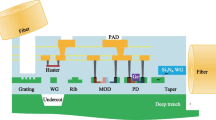Abstract
The Internet is evolving from best-effort service toward an integrated or differentiated service framework with quality-of-service (QoS) assurances that are required for new multimedia service applications. Given this increasing demand for high bandwidth Internet with QoS assurances in the coming years, an IP/MPLS-based control plane combined with a wavelength-routed dense wavelength division multiplexing (DWDM) optical network is seen as a very promising approach for the realization of future re-configurable transport networks. Fault and attack survivability issues concerning physical security in a DWDM all-optical transport network (AOTN) require a new approach taking into consideration AOTN physical characteristics. Furthermore, unlike in electronic networks that regenerate signals at every node, attack detection and isolation schemes may not have access to the overhead bits used to transport supervisory information between regenerators or switching sites to perform their functions. This paper presents an analysis of attack and protection problems in an AOTN. Considering this, we propose a framework for QoS guarantees based on the differentiated MPLS service (DMS) model and QoS recovery schemes against QoS degradation caused by devices failures or attack-induced faults in an AOTN. We also suggest how to integrate our attack management model into the NIST’s simulator—modeling, evaluation and research of lightwave networks (MERLiN).
Similar content being viewed by others
References
R. Braden, D. Clark, S. Shenker, Integrated services in the Internet architecture: An overview, Internet RFC 1633, (June 1994).
R. Braden, L. Zhang, S. Berson, S. Herzog, S. Jamin, Resource ReSerVation Protocol (RSVP)–Version 1, Functional specification, Internet RFC 2205, IETF, (September 1997).
S. Shenker, C. Partridge, R. Guerin, Specification of the guaranteed quality of service, Internet RFC 2212, (September 1997).
V. Jacobson, K. Nichols, K. Poduri, An expedited forwarding PHB, Internet RFC 2598, (June 1999).
S.–K. Lee, S.–U. Kim, Standards activities for optical transport networks in ITU–T, Optical Network Magazine, vol. 2,no. 2, (March–April 2001), pp. 82–84.
D. Awduche, Y. Rekhter, J. Drake, R. Coltun, Multi–Protocol lambda switching: Combining MPLS traffic engineering control with optical crossconnects, IETF Internet Draft, draft–awduche–mpls–te–optical–03.txt, (April 2001), work in progress.
J. Patel, S. Kim, D. Su, Attack management for all optical transport networks, submitted to IEEE Journal on Survey and Tutorial.
A. Jukan, A. Monitzer, H. R. van As, QoS–restorability in optical networks, Proc. of 24th European Conference on Optical Communication (ECOC'98), vol. 1, (Madrid, Spain, September 20–24, 1998), pp. 711–712.
K. Nicholas, S. Blake, F. Baker and D. Black, Definition of the differentiated services field (DS Field) in IPv4 and IPv6 headers, Internet RFC 2474, IETF, (December 1998).
B. Jamousi: Constraint–based LSP setup using LDP, Internet draft–ietf–mpls–crldp–04.txt, IETF, (July 2000).
J. Heinanen, F. Baker, W. Weiss, J. Wroclawski, Assured forwarding PHB group, Internet RFC 2597, (June 1999).
N. Golmie, T.D. Ndousse, D. Su, Differented optical services model for WDM networks, IEEE Communications Magazine, vol. 38,no. 2, (February 2000), pp. 68–73.
R. Ramaswami, K. N. Sivarajan, Optical networks: A practical perspective, (Morgan Kaufmann Publishers, Inc., San Francisco, CA, 1998).
S. R. Chin, Simplified modeling of transients in gain–clamped erbium–doped fiber amplifier, IEEE/OSA Journal of Lightwave Technology, vol. 16,no. 6, (June 1998), pp. 1095–1100.
M. Ali, B. Ramamurthy, J. S. Deogun, Routing and wavelength assignment (RWA) with power considerations in all–optical wavelength–routed networks, Proc. of 1999 IEEE Global Communications Conference (GLOBECOM'99), vol. 2, (Rio de Janeiro, Brazil, December 5–9, 1999), pp. 1433–1437.
L. Gillner, C. P. Larsen, M. Gustavsson: Scalability of optical multiwavelength networks, crosstalk analysis, IEEE/OSA Journal of Lightwave Technology, vol. 17,no. 1, (January 1999), pp. 58–67.
Y. W. Lai, Y. K. Chen, W. I. Way, Novel supervisory technique using wavelength–division–multiplexed OTDR in EDFA repeatered transmission systems, IEEE Photonics Technology Letters, vol. 6,no. 3, (March 1994), pp. 446–449.
A. Fumagalli, and L. Valcarengh:IP restoration vs. WDM protection: Is there an optimal choice?” IEEE Network, vol. 14,no. 6, (November/December 2000), pp. 34–41.
http://w3.antd.nist.gov/Hsntg/prd_merlin.html.
Rights and permissions
About this article
Cite this article
Patel, J.K., Kim, S.U. & Su, D.H. QoS Recovery Schemes Based on Differentiated MPLS Services in All-Optical Transport Next Generation Internet. Photonic Network Communications 4, 5–18 (2002). https://doi.org/10.1023/A:1012915603479
Issue Date:
DOI: https://doi.org/10.1023/A:1012915603479




